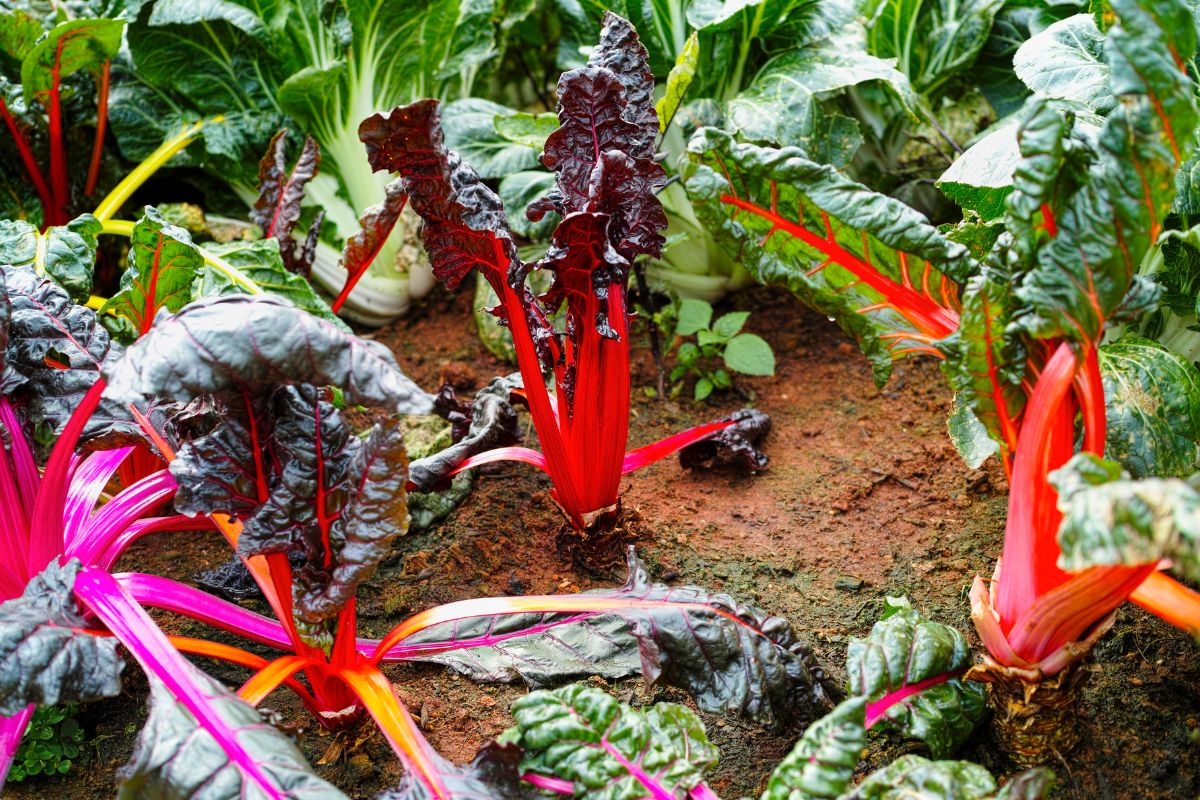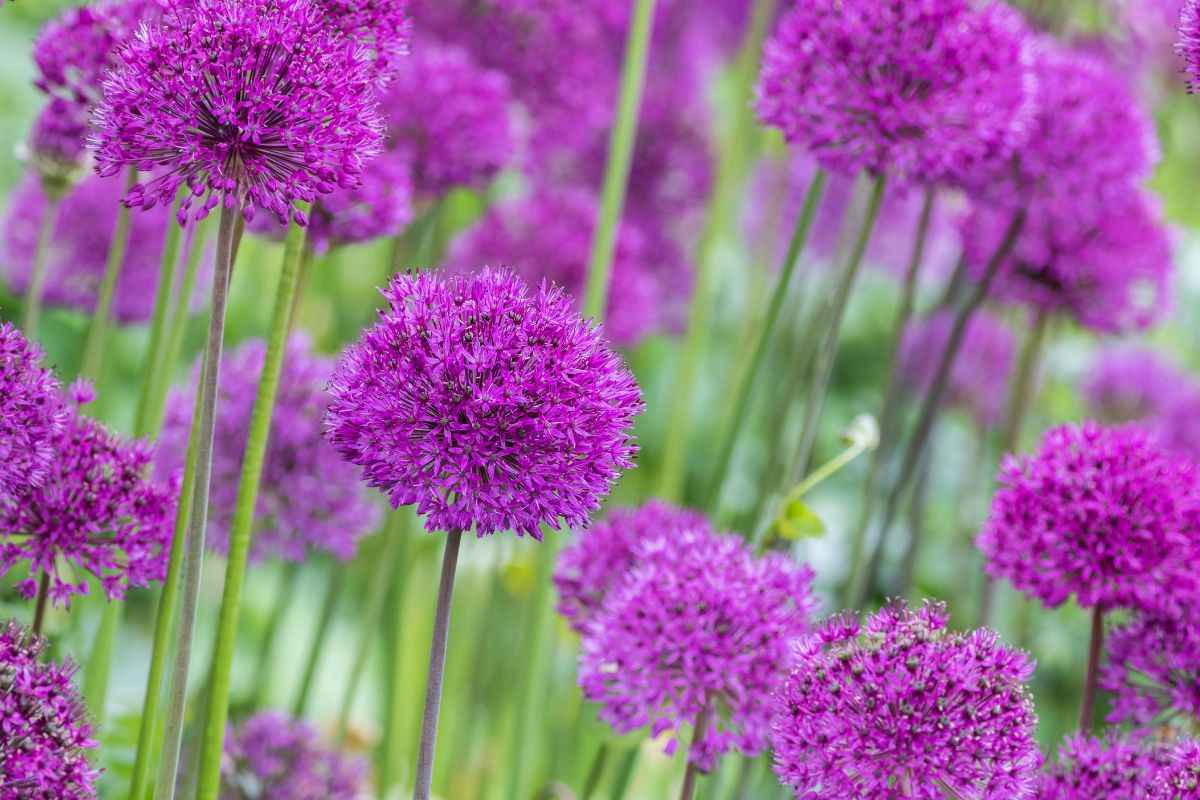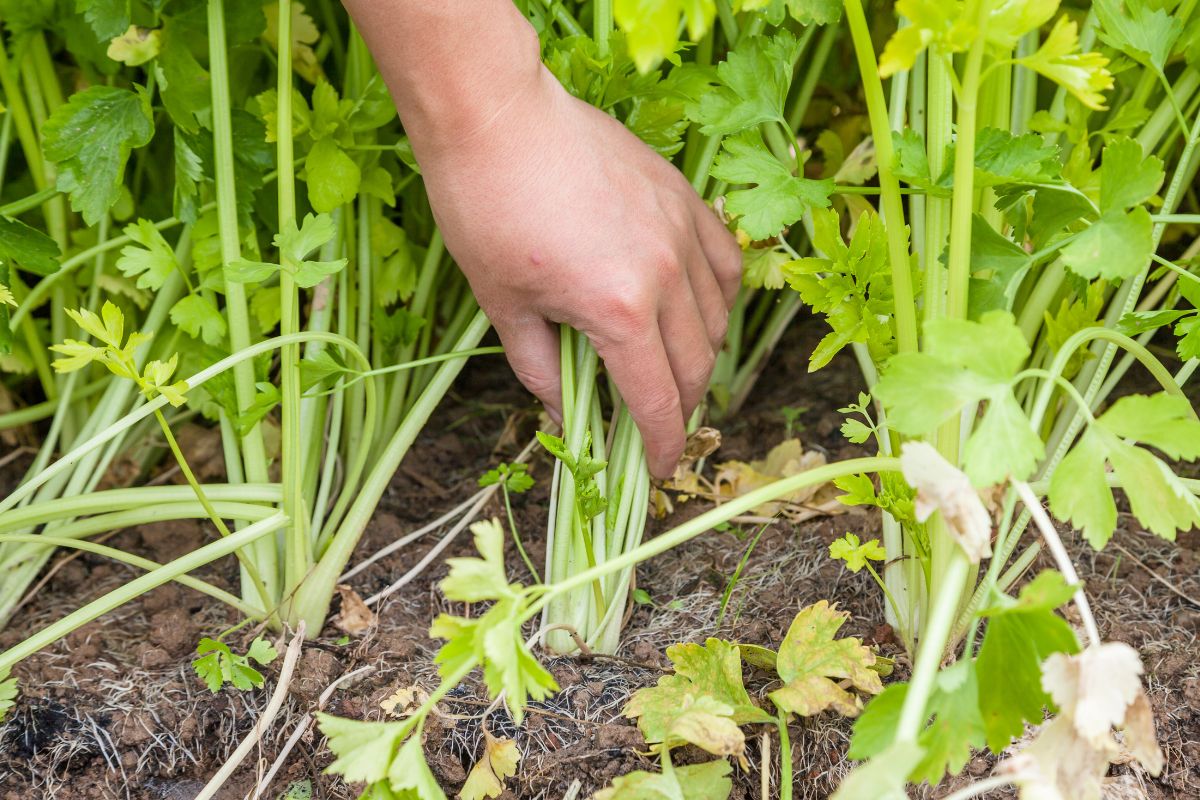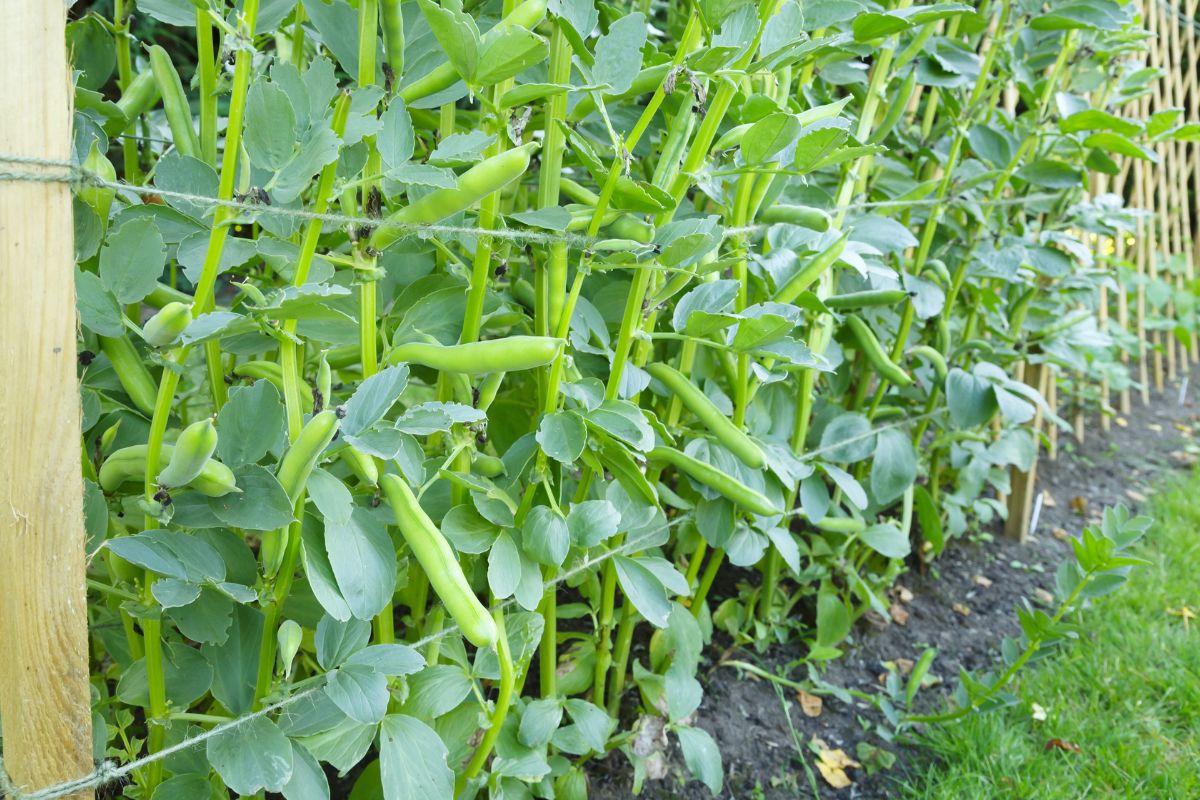What is Swiss Chard?
Swiss chard is a green leafy vegetable rich in vitamins and minerals and can easily withstand high temperatures. Also, you should plant it with Swiss chard companion plants for better growth and higher yields.
Are you planning to grow chard in your garden? Are you unsure of the companion plants for the swiss chord you should use? This post will sort you out!

What NOT to Plant Next to Swiss Chard
Swiss chard does not grow well with all plants. This is because some plants attract pests or compete for nutrients with the chard plants. Do you know what these plants are?
First, you should avoid sunflowers which are allelopathic. They release chemicals from their leaves, stems, and roots that harm nearby plants. These chemicals hinder seed germination. They also cause stunt growth in seedlings of many plants.
Second, experts advise that you should avoid growing the Swiss chard with members of the goosefoot family. Examples of such plants are quinoa, beets, amaranth, and spinach.
This advice helps to control pests and diseases. Plants in the goosefoot family usually attract the same pests and are predisposed to similar pathogens. If a pest has an affinity for one type of vegetable, it usually attacks related vegetables.
Therefore, if you spread out members of the same family, it will help slow down pests. You can also slow down the spread of diseases.
Alternatively, you can simplify crop rotation by grouping members of the same family together but creating buffers between them. You can use alliums, lettuce, herbs, or marigolds to create buffers, as they confuse and slow down the pests.
Additionally, traditional literature claims corn and potatoes are not great companions for Swiss chard. Because they are voracious feeders, they will compete for nitrogen in the soil.
Furthermore, cucurbit family members, like cucumbers, melons, squash, and gourds, also make bad companions for chards. This is because the trailing vines of cucurbits can overwhelm, strangle and cover the Swiss chards. Moreover, the cucurbits are heavy feeders and will take away nutrients from the soil.
Here are the plants you should not plant next to Swiss chard:
| Companion plant | Why it is unsuitable |
| Sunflowers | They take away sin and release destructive substances into the soil. |
| Melons, cucumbers, and pumpkins | These plants take away nutrients and could choke the chards. |
| Beets, quinoa, and potatoes | These companions are unsuitable because they attract pests. |
| Corns | The corn competes for nutrients with the Swiss chards. |
Recommended Swiss Chard Companion Plants
As you look for what to plant next to Swiss chard? It is important to remember that the Swiss chard is a light feeder. Moreover, it is not prone to pest and disease problems.
As a result, it is usually an excellent companion for many plants. On the other hand, there are many different types of plants that can be good companions for the Swiss chord.
While there are many options for Swiss chard companions, here are seven of the top good neighbors to start with:
Alliums
Alliums have numerous benefits as companion plants. For example, a strong odor makes alliums like shallots, leeks, onions, garlic, and shives usually help to repel undesirable insects. On the other hand, when they bloom, they attract helpful insects like bees, wasps, and hoverflies.
Many people love chives because of their beautiful globe-shaped flower heads, which are effortless to harvest. Furthermore, they pack a strong punch of garlicky aroma. They are also easy to grow from seed.
Chives are also beneficial because they bloom early, providing food sources for beneficial predatory insects that help reduce pest populations.

Annual Flowers
A wide range of annual flowers makes excellent Swiss chard companions. Some Swiss chard varieties are very colorful that they would look out of place in your flower bed.
Marigolds are useful garden neighbors because they can repel root-knot nematodes and pests. Nasturtiums are excellent garden companions because their flowers usually attract helpful insects. Also, their leaves have a strong scent that repels certain pests, including aphids.
The sweet alyssum is another great companion for several reasons. For example, it provides ground cover that helps to keep weeds at bay. Moreover, it shades the soil around the plants. Their sweet alyssum flowers have a fragrance that attracts helpful insects, including hoverflies, that help keep aphid populations in check.
Consider the ‘Carpet of Snow,’ a sweet asylum variety providing excellent ground cover. It usually grows up to five inches tall, producing numerous small flowers.
Brassicas
Many companion planting literature cites cabbage as a suitable Swiss chard companion. Other cabbage family members, such as radishes, kale, turnips, broccoli, and Kohlrabi, are also good companions.
One of the main benefits of cabbage is that it has a shallow root system, while the Swiss chard roots go relatively deeper. In the same way, you don’t want the plant portions above the ground to fight for space. It will help if the underground portions are not fighting for space also. Grouping plants having complementary root depths is a popular strategy in companion planting.
Celery
Celery is a compact plant that makes an excellent Swiss chard companion. Its properties above and below ground are friendly to the Swiss chard. Celery is a good companion if you grow it as a fall crop.
Moreover, the cool autumn weather sweetens both plants. Many gardeners usually buy celery as the nursery starts to transplant them into their gardens. However, you can only grow celery from seed, allowing you to choose from different varieties.

Herbs
Companion planting literature claims that not all herbs are great Swiss chard companion plants. For example, many gardeners claim that dill or cilantro make great companions for Swiss chard.
Some of its benefits include attracting beneficial insects like hoverflies and wasps. Additionally, lavender, lovage, and marjoram also make excellent companions for chard. However, mint seems to have the best reputation of all herbs.
If you allow the mint to bloom, it will attract helpful insects thanks to its numerous flowers. The plant also repels flea beetles, a common pest that targets the Swiss chard.
Furthermore, the fragrant compounds in mint also mask the smell of other plants. This makes it challenging for pests to locate the host plants. But, if you choose to grow mint as a Swiss chard companion, keep it in a container. This approach will help you prevent it from taking over your entire vegetable patch.
There are wide mint varieties available. But peppermint is preferable because it has a fresh taste, is clean, and has cooling properties. Moreover, mint is a wonderful herb to have in your garden. You can use it to make homemade iced herbal tea.
Legumes
Legumes are great companion plants for Swiss chard because it helps fix nitrogen in the soil. In this regard, peas and bush beans are normally the best companions for Swiss chard. Besides, most companion planting experts claim that pole beans are a good choice.
This is because of the crop’s towering nature when you trellis it. Peas are also trellised but die back in late spring or early summer. This is usually when pole beans are taking off and can potentially shade your Swiss chard crop.
For this reason, experts suggest you should not include pole beans as a garden companion. However, there is a workaround. For example, you can plant your Swiss chard on the pole bean’s trellis. This approach ensures your Swiss chard gets full sun.
Other legumes you can try out as Swiss chard companions include garbanzo beans and fava beans. In the meantime, you can stick with bush beans as the nitrogen-fixing companion for your Swiss chords.

Lettuce
Lettuce makes an excellent Swiss chord companion. Growing these leafy veggies side by side helps maximize your garden’s space. Moreover, it makes your salad harvests effortless.
Besides that, lettuce has a shallow system meaning it will not compete with your Swiss chard for underground space. Additionally, using lettuce as a garden companion is helpful because it provides living mulch. It covers the soil preventing weeds from popping up. Furthermore, it slows erosion and water evaporation.
There are numerous lettuce varieties that are both beautiful and delicious. Some types are better at offering living mulch. In this sense, consider picking a combination that has a more spreading growth habit. One famous example is Batavian. Like Romaine, avoid lettuce varieties with an upright growth habit.
Here is a summary of great Swiss chard companion plants and their benefits.
| Companion plant | Benefits |
| Celery, marjoram, basil, leeks, onions, and garlic | These companion plants keep away pests. |
| Onion, leeks, and garlic | These plants keep away pests and harmful insects. |
| Lettuce | Prevents weeds from spreading. |
| Bush beans and peas | They help to fix nitrogen in the soil. |
| Rosemary, thyme, and lavender | These companion plants improve your Swiss chard’s flavor. |
| Mint | This Swiss chard buddy helps to attract good insects while keeping away flea beetles. |
| Cabbage, radishes, collard greens, Kohlrabi, and kale | These plants help to loosen the soil. |
| Tropaeolum | This plant attracts pollinators and repels aphids. |
Another popular question is–can you plant Swiss chart with tomatoes? Yes, you can use tomatoes as Swiss chard companion plants. They usually do well when you pair them with the chard.
Tomatoes are excellent companions because the chard is a cool-season crop that matures long before your tomatoes go. Moreover, you can train the tomato plants to grow on stakes. This approach will keep them off the ground leaving enough room for the chard to thrive.
Is Chard a Brassica?
While the Swiss chard is a popular vegetable in many gardens globally, many people don’t know which family it comes from. So, is chard a Brassica?
Chard does not belong to the brassica family. Also, it does not relate closely to the brassicas. The popular plant comes from Chenopodiaceae. Moreover, within that family, the Swiss chard belongs to the beta genus.
Other members of the beta genus are sugarbeet and beetroot. People mostly use sugarbeet to produce raw sugar in cooler countries that cannot grow sugar cane.
On the other hand, the brassica family’s common members, cabbage, kale, cauliflower, Kohlrabi, and broccoli, belong to the same genus. They belong to the Brassica oleracea species. Therefore, you can consider these to be varieties rather than different species.
You can consider uninitiated individual plants to be the same species. This is if they can cross-pollinate and produce viable offspring. All these plants can interbreed and produce new varieties like broccoflower. Moreover, all originated from European wild cabbage, like the Swiss chard.
The Swiss chard is a plant having many different names, including beet spinach, leaf beet, Seakale beet, Silverbeet, and perpetual spinach. You can trace the plant’s origin to southern Europe. It developed from a wild form, and many people have cultivated it for thousands of years.
The common forms of the Swiss chard are white, yellow, and green. People have used these varieties for thousands of years, and they appear in the writings of several Greek scholars.
You will find the first mention of the red-stalked varieties around 350 BC. Moreover, you can plant the crop for ornamental and edible properties. It is a hardy biennial plant that produces leaves throughout the year in relatively cold climates.
This means the Swiss chard has advantages over other greens like lettuce and seed, which go seed in a few months. So, the Swiss chard is in the Family Chenopodiaceae. Here are some of its attributes:
- It is a beet variety that does not produce edible fruit.
- It is a biennial plant, but people grow it annually for its big crinkly leaves and wide crunchy stems.
- The Swiss chard’s leaves also have enlarged midribs.
- You can use it as a decorative plant in your flower garden.
- It is a Mediterranean native that was popular food before the Roman Empire.
- In southern France, people grew the plant to eat it exclusively at Christmas.
- The plant grows better in cool temperatures because high temperatures usually slow down leaf production.
- It also grows well regardless of the soil type and day length.
There are wide varieties of Swiss chard. Their main differences are petiole and leaf color, and the colors vary from white to yellow. On the other hand, petiole and midrib colors also vary from white to yellow, red, orange, or green.
Their leaves are either purple, bronze, or green. The common varieties include
- Bright Lights: This is a 1998 All-American selection that gardeners improved for its stem colors. Its petioles can be gold, yellow, white, orange, pink, or striped. People mostly use it as an ornamental. It takes around 55 days to mature.
- Fordhook Giant: This variety has thick, broad white midribs and petioles. It also has deeply creased, dark green leaves. Moreover, it grows 24 to 28 inches tall.
- Lucullus: This older variety produces very wide and chunky white or pale green petioles. Its leaves are dark green and creased. Furthermore, this variety grows well in freezing temperatures and matures after 55 days.
- Neon Lights: This Swiss chard variety is a blend of five colors more concentrated than “Bright Lights.”
- Rainbow: This is a combination of various colored varieties.
- Rhubarb: This Swiss chard variety produces creased, dark green leaves having deep red veins. Its petioles are bright crimson red and a bit flattened. It matures in around 60 days. Moreover, it is an excellent ornamental.
- Silverado: This compact green variety usually grows up to 16 inches tall. You can harvest it for individual stems or as a whole plant. You can individually reap the plant’s white stems and creased intensely dark leaves. The plant usually matures after around 65 days.
Why to Plant Companion Plants With Swiss Chard
Planting companion plants with Swiss chard is a natural way of diversifying the plants in your garden. A diversified garden helps prevent pests and diseases that usually affect species.
It also creates safe habitats that act as safe havens for helpful creatures. Companion plants also reduce human involvement allowing you to create a more organic garden. However, you must get the right companion plants for the desired benefits.
The companion plants for Swiss chard should do the following:
- The plants should be able to keep away pests and harmful insects.
- Go for plants such as legumes that help to fix nitrogen in the soil.
- Moreover, consider plants that can help improve the flavor of your Swiss chard.
- Gardening experts also suggest that it would help to go for Swiss chard companions that attract good insects and keep away flea beetles.
- It also helps to blend your Swiss chard crops with plants that provide ground cover to conserve soil moisture and prevent the growth of weeds.
- It is also best to grow plants whose attributes under the soil and above the soil complement the Swiss chard characteristics. For example, plants with shallow roots work well with the Swiss chard, which has a deeper root system.
- You should also consider plants like the Kohlrabi and radishes that loosen the soil allowing your Swiss chard to thrive.
- Finally, you should consider plants that attract pollinators.
Parting Thoughts
The Swiss chard is an excellent addition to your garden. Furthermore, there are wide varieties of plants that you can plant in your garden. You can plant them for food purposes or purely cosmetic reasons.
Besides that, it helps to plant other Swiss chord companions in your garden to improve the health and look of your garden. As you have read from this piece, there are different companion plants for Swiss chard that you can select from.
Your objective will help determine the type of companion plant you should go for. For example, do you want to repel pests, attract helpful insects or create living mulch? On the other hand, are you looking for Swiss chard companions to boost nitrogen in your soil?
Answering these questions will help you select the right plant companion for your Swiss chard. On the other hand, you should avoid plants that attract harmful pests or emit toxic substances into the soil. Additionally, avoid plants that compete for nutrients with the chard plants or those that may strangle your Swiss chard plants.
At this point, you have all the details you need to grow Swiss chard successfully. You also know what to avoid planting next to your chards. Are you ready to let your Swiss chard to be-leaf in its friends?
